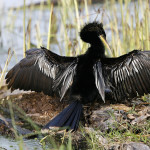• • •
Anhingas are odd looking birds – both in the water and out. Their plumage is largely black, with distinctive white streaks on the wings and back. Their long, sinewy neck ends in a tapered yellow beak that they can snake all over their bodies as they preen.
• Length: 35 inches
• Wingspan: 45 inches
• Season: Year-round
More about Anhingas.
Where they are, and when.
Anhingas ride low in the water as they swim, showing only their neck and head, because their plumage soaks up water more quickly than other birds. From there, they slip down among the submerged vegetation to forage for fish, spearing them in the side with their sharp bills. Sometimes, they spread their wings while under the water to lure fish into the shadows they create, striking quickly as the fish swim by.
When they’re done, they perch on a bank or tree branch with their wings outstretched in the sun to dry. It can go on for hours because they’re not just drying but warming themselves as well. They lack the insulating feathers of their cousins, the cormorants.
Female Anhingas have the same dark wings and body but their neck and head are a buff color. The Anhinga’s large wings enable it to soar and glide with only a few wing beats in between.
Anhingas nest in small colonies that they sometimes share with herons. They build a platform nest of sticks in a tree, where they nuture several pale, blue-green eggs.






You must be logged in to post a comment.